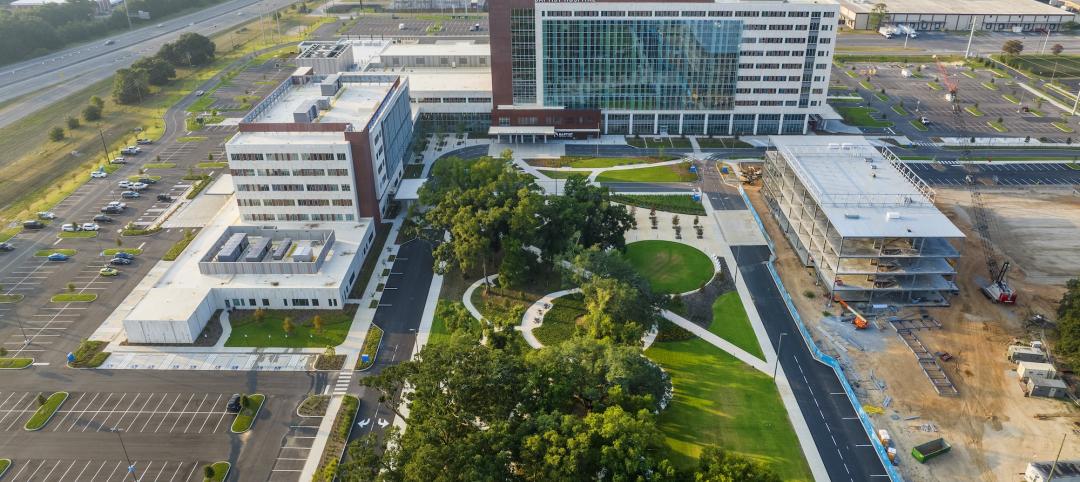The healthcare industry has undergone a technology renaissance. What once encompassed patient scheduling and payment software has evolved into a myriad of applications and IoT devices (internet of things) that are often critical to the delivery of healthcare services. These changes to the healthcare industry have increased the need for IT infrastructure and data center capacity. However, despite the proliferation of technology in the healthcare sector, many healthcare companies aren’t providing the correct or adequate data center and IT infrastructure solutions to support their organizations’ growing technology needs. This article outlines the current data center landscape in the healthcare sector, industry trends, and challenges and opportunities new technologies present to the healthcare space.
Current Healthcare IT Landscape
From an IT perspective, the healthcare landscape is extremely complex and fluid. Consolidation and merger and acquisition (M&A) activity has caused organizations to inherit portfolios of often disparate or duplicative data center and IT assets. The typical combination of owned and leased data center assets are a mixed bag, often in the wrong location and inconsistent from a design and operation perspective. Consolidation and M&A events are the perfect catalyst for a reevaluation of data center and IT strategy. IT refresh periods should be used to rightsize data center portfolios and dispose underutilized and obsolescent data center capacity. However, it’s challenging to develop a strategy to conform to changing business, technology and regulatory environments.
As outsourcing in the healthcare industry becomes more prevalent, migration to third-party solutions seems to be a natural progression, allowing healthcare organizations to focus on their patients and alleviating the responsibilities and risks associated with owning a data center. As data center strategies become multi-faceted, IT and real estate decision-makers face the reality that their data center facilities may not be capable of accommodating cloud, virtualization and active-active architectures—all components of the evolving IT stack and often critical to a successful strategy. The trend toward third-party solutions has also enabled companies to hedge financial risks. Having the ability to scale data center footprints and IT technologies helps mitigate unnecessary spending and manages the risk of incorrect IT forecasting and capacity planning errors.
The complexity of matching data center strategies with evolving IT is exacerbated when options like cloud, managed services and virtualization are thrown into the equation. These options complicate the IT stack and contribute to a departure from traditional space and power discussions. By combining services beyond traditional power and space, the line between real estate and IT becomes blurred. This only adds to the difficulty of formulating a cohesive strategy since there is often a mismatch of IT needs and perceptions between real estate, IT and the procurement arms of an organization.

Industry Trends
Adapting to changing business and IT environments, healthcare companies are seeking flexible and scalable data center solutions to support emerging technologies. Often these requirements can’t be met in a single-owned data center facility and thus migrations to third-party solutions are taking place (i.e., colocation, cloud or other third-party environment). Besides the scalability benefits, healthcare companies are migrating to third-party solutions to support new and emerging technologies. Facility density, resiliency, location, connectivity, compliance certifications, hybrid IT services and other attributes play into the effective deployment and growth of these new technologies.
As healthcare organizations continue to look at reducing costs, data centers can prove to be a lucrative area for both short and long-term savings opportunities. With increasing healthcare real estate values, there’s often a financial benefit to repurposing traditional “on premise” data center space. This can also help mitigate occupancy constraints in existing healthcare facilities while providing more revenue-generating space. Migrating to third-party solutions also allows end users to take advantage of variable cost savings associated with different geographies, power, taxes, incentives, real estate, network and staffing. These variables are static in an owned data center scenario. Despite all of the benefits of migrating to a third-party solution, some organizations remain hesitant as they struggle with misconceptions around control of the data center, compliance and location.
With the shift toward third-party solutions, many legacy data center assets are becoming obsolete to organizations’ evolving IT strategies. Apart from obsolescence, other data center challenges healthcare organization face include:
● Underutilization
● Extensive capital expenditures
● Inefficient densities
● Security concerns
● Escalating operating costs
Although these assets may not be suitable for a healthcare entity to own and operate, many healthcare organizations are successfully offloading the liabilities of these data center assets and monetizing them in the form of Sale-Leaseback or Sale-Partial Leaseback transactions. This strategy can be ideal when looking to minimize Capex exposure, raise capital and remain in the same data center building without the perils of maintaining aging infrastructure. Even though investors’ appetites for data center assets are high, end users should be cautioned that not all legacy data centers are diamonds in the rough. Tenant credit rating, facility quality, lease terms and location all weigh heavily on the valuation. “If I have an opportunity to minimize my capital expenditures, that’s something I am going to look at,” said Daniel Morreale, CIO of Riverside Healthcare, in a recent Clear Data article. He also noted the growth of data storage requirements is on a steep curve, which will continue to rise with the growth of picture archiving and communication system (PACS) across cardiology and other non-radiological medical specialties.

Security & Compliance
Security concerns have been a catalyst for migrating to third-party solutions as Chief Information Officers (CIOs) and IT professionals begin to grasp the severity of security breaches. Data center and cloud providers have responded with offerings that address these concerns from a physical standpoint and virtual approach, rolling cybersecurity services into their offering.
Healthcare organizations are closely evaluating the criticality of applications and matching them with the appropriate tiering requirement support, a radical shift from the tradition Tier III and above data center solution. This shift in thinking has allowed healthcare organizations to realize the substantial savings that providers can offer through non-redundant (“N”) data center offerings, ideal for organizations that process large amounts of data for test and development, research, high-performance computing and non-mission-critical applications. As enterprises look to segment applications by criticality, the need for colocation, cloud and hybrid IT technologies becomes even more crucial.
Compliance issues like HIPAA (Health Insurance Portability and Accountability Act) continue to be a major burden and expensive effort for in-house data centers. In addition, the Affordable Care Act (ACA) has increased the number of patient records, driving growth in the data center. Multiply growth in the number of patients by the number of procedures, such as CAT scans or MRIs, and the effect on data becomes apparent. With doctors, nurses and technicians using mobile devices to check patients, data centers must be maintained to a zero fail rate and designed with enough flexibility to grow on demand.
IT Strategy
As companies develop and refine their IT strategies, discussions around traditional power and space are becoming less of a focus. Successful strategies begin by quantifying IT needs from a workload perspective and identifying the other applications necessary to complete the data center plan. By taking a more granular approach to understanding workloads and growth of the organization, IT and real estate leaders can more effectively align resources to ensure capital is being deployed and technology assets are being used to their fullest potential. A flexible and scalable data center strategy should also help mitigate unnecessary expenditures, reduce underutilized data center space and offer substantial cost savings.
While the approach for formulating a data center strategy is important, so is its life cycle. Effective strategies should be ahead by a minimum of 24 months and should address changes inside and outside of the healthcare organization. These extended lead times will help IT and real estate decision-makers review their data center portfolio and assess existing technologies. This will allow time to evaluate new technologies to implement across the organization.
For organizations with leased data center assets, it’s crucial to assess renewals and expiring leases more than two years in advance. On average, data center lease rates are 25% lower than they were three to five years ago, offering substantial savings. The benefit of renewals and renegotiating leases goes beyond rental rates as service level agreements (SLAs) may become more favorable to end users. These SLAs can be incredibly important to healthcare organizations as a majority of their data center applications are mission critical and don’t allow for downtime. Allowing a 24-month lead time gives IT teams the opportunity to develop and execute a migration strategy should the terms be favorable in other locations.
Since today’s data center strategies are made up of so many components, it’s important to open lines of communication across IT, real estate and procurement departments. Many organizations are plagued by self-sourced technology, business lines within procuring servers or applying for cloud subscriptions since the organization’s technology can’t move quickly enough. This is a textbook example as to why it’s difficult to calculate an organization’s true IT spend and footprint.
Conclusion
As technology continues to evolve and shape the healthcare industry, it’s critical that data center decision-makers understand the options available when creating their optimal data center strategy. While traditional power and space are still a cornerstone of data center strategies, the IT stack has grown in complexity; cloud, managed services and virtualization are now key components and allow organizations to mitigate traditional challenges of growth, forecasting and owning traditional IT and data center infrastructure.
IT and real estate leaders should also view the prevalence of consolidation and M&A activity as an opportunity for their organizations to refine and develop their data center strategy, taking time to quantify and optimize assets in their IT and real estate portfolios. With a better understanding of these portfolios, end users are increasingly migrating to third-party solutions as owning and operating data centers isn’t their core competency.
This move toward third-party solutions has allowed healthcare providers to realize the benefits of a flexible, secure and scalable environment for their IT hardware and applications. Although technology is fluid and constantly evolving, developing effective IT and data center strategies in the healthcare industry is becoming increasingly important. As the delivery of healthcare services and the success of healthcare organizations can often hinge on these factors, IT and real estate leaders need to be certain they’re making the right data center decisions for the future.
Related Stories
Giants 400 | Jan 15, 2024
Top 130 Hospital Facility Architecture Firms for 2023
HKS, HDR, Stantec, CannonDesign, and Page Southerland Page top BD+C's ranking of the nation's largest hospital facility architecture and architecture engineering (AE) firms for 2023, as reported in the 2023 Giants 400 Report.
Healthcare Facilities | Jan 7, 2024
Two new projects could be economic catalysts for a central New Jersey city
A Cancer Center and Innovation district are under construction and expected to start opening in 2025 in New Brunswick.
Designers | Jan 3, 2024
Designing better built environments for a neurodiverse world
For most of human history, design has mostly considered “typical users” who are fully able-bodied without clinical or emotional disabilities. The problem with this approach is that it offers a limited perspective on how space can positively or negatively influence someone based on their physical, mental, and sensory abilities.
Healthcare Facilities | Dec 19, 2023
A new hospital in Duluth, Minn., is now the region’s largest healthcare facility
In Duluth, Minn., the new St. Mary’s Medical Center, designed by EwingCole, is now the largest healthcare facility in the region. The hospital consolidates Essentia Health’s healthcare services under one roof. At about 1 million sf spanning two city blocks, St. Mary’s overlooks Lake Superior, providing views on almost every floor of the world’s largest freshwater lake.
Healthcare Facilities | Dec 7, 2023
New $650 million Baptist Health Care complex opens in Pensacola
Baptist Health Care’s new $650 million healthcare complex opened recently in Pensacola, Fla. Featuring a 10-story, 268-bed hospital, the project “represents the single-largest investment in the healthcare history of northwest Florida,” said Gresham Smith project executive Robert “Skip” Yauger, AIA, LEED AP. The 602,000 sf Baptist Hospital is equipped with a Level II trauma center that provides 61 exam rooms and three triage areas.
Engineers | Nov 27, 2023
Kimley-Horn eliminates the guesswork of electric vehicle charger site selection
Private businesses and governments can now choose their new electric vehicle (EV) charger locations with data-driven precision. Kimley-Horn, the national engineering, planning, and design consulting firm, today launched TREDLite EV, a cloud-based tool that helps organizations develop and optimize their EV charger deployment strategies based on the organization’s unique priorities.
Healthcare Facilities | Nov 3, 2023
The University of Chicago Medicine is building its city’s first freestanding cancer center with inpatient and outpatient services
The University of Chicago Medicine (UChicago Medicine) is building Chicago’s first freestanding cancer center with inpatient and outpatient services. Aiming to bridge longstanding health disparities on Chicago’s South Side, the $815 million project will consolidate care and about 200 team members currently spread across at least five buildings. The new facility, which broke ground in September, is expected to open to patients in spring 2027.
Sponsored | | Oct 17, 2023
The Evolution of Medical Facility Security
As the healthcare system grows, securing these facilities becomes ever more challenging. Increasingly, medical providers have multiple facilities within their networks, making traditional keying systems and credentialing impractical.
Healthcare Facilities | Oct 11, 2023
Leveraging land and light to enhance patient care
GBBN interior designer Kristin Greeley shares insights from the firm's latest project: a cancer center in Santa Fe, N.M.
Healthcare Facilities | Oct 9, 2023
Design solutions for mental health as a secondary diagnosis
Rachel Vedder, RA, LEED AP, Senior Architect, Design Collaborative, shares two design solutions for hospitals treating behavioral health patients.

















